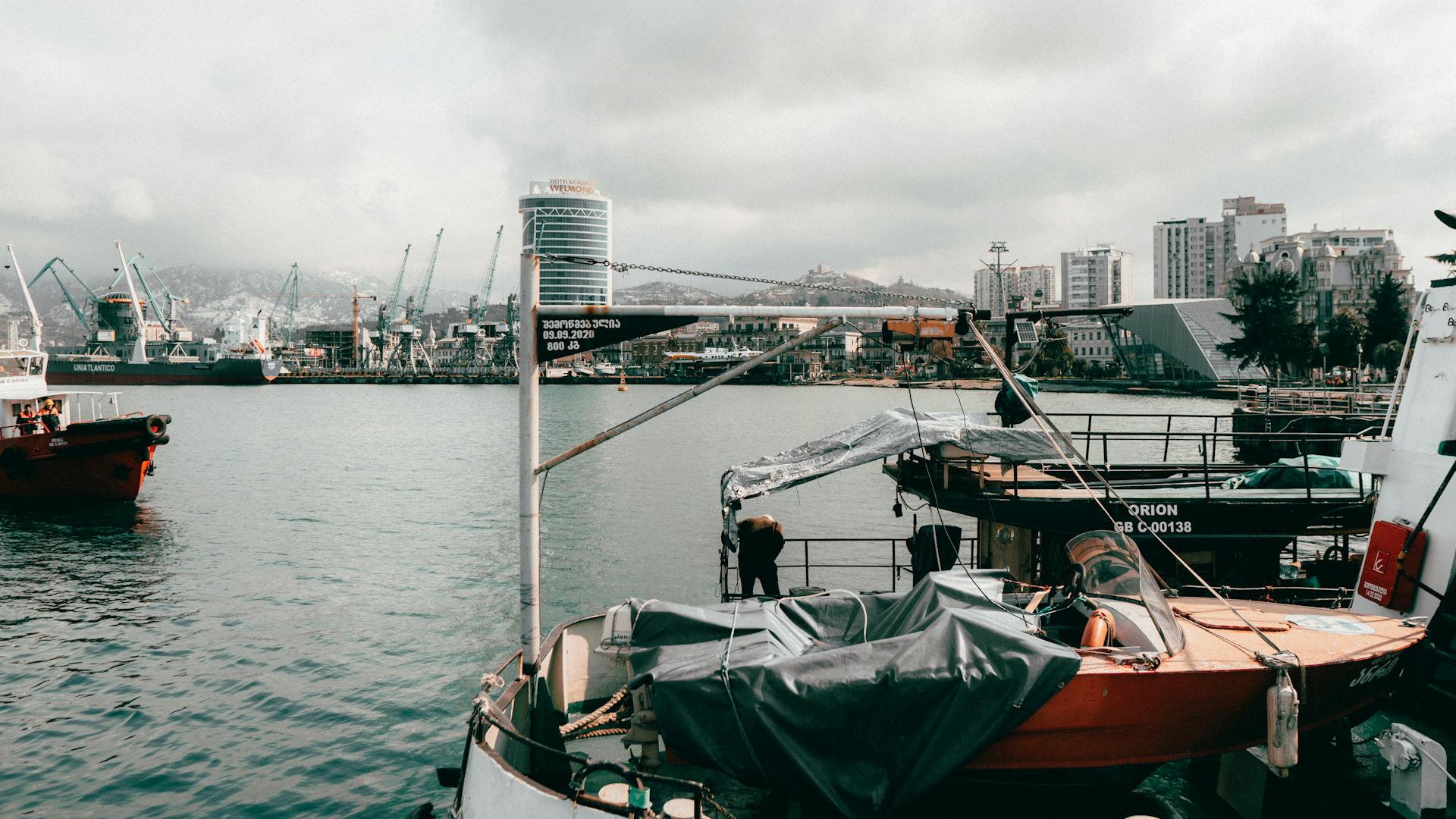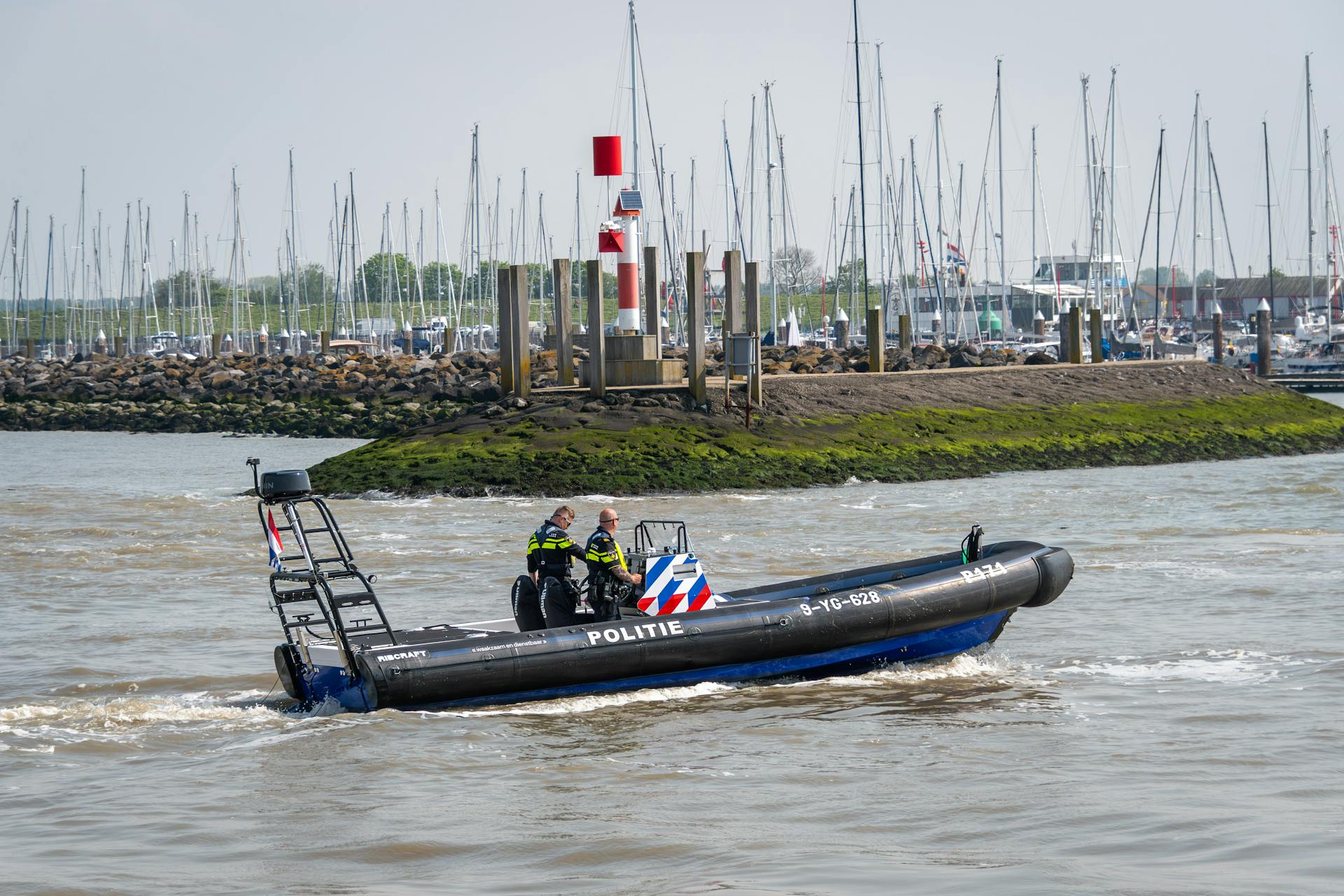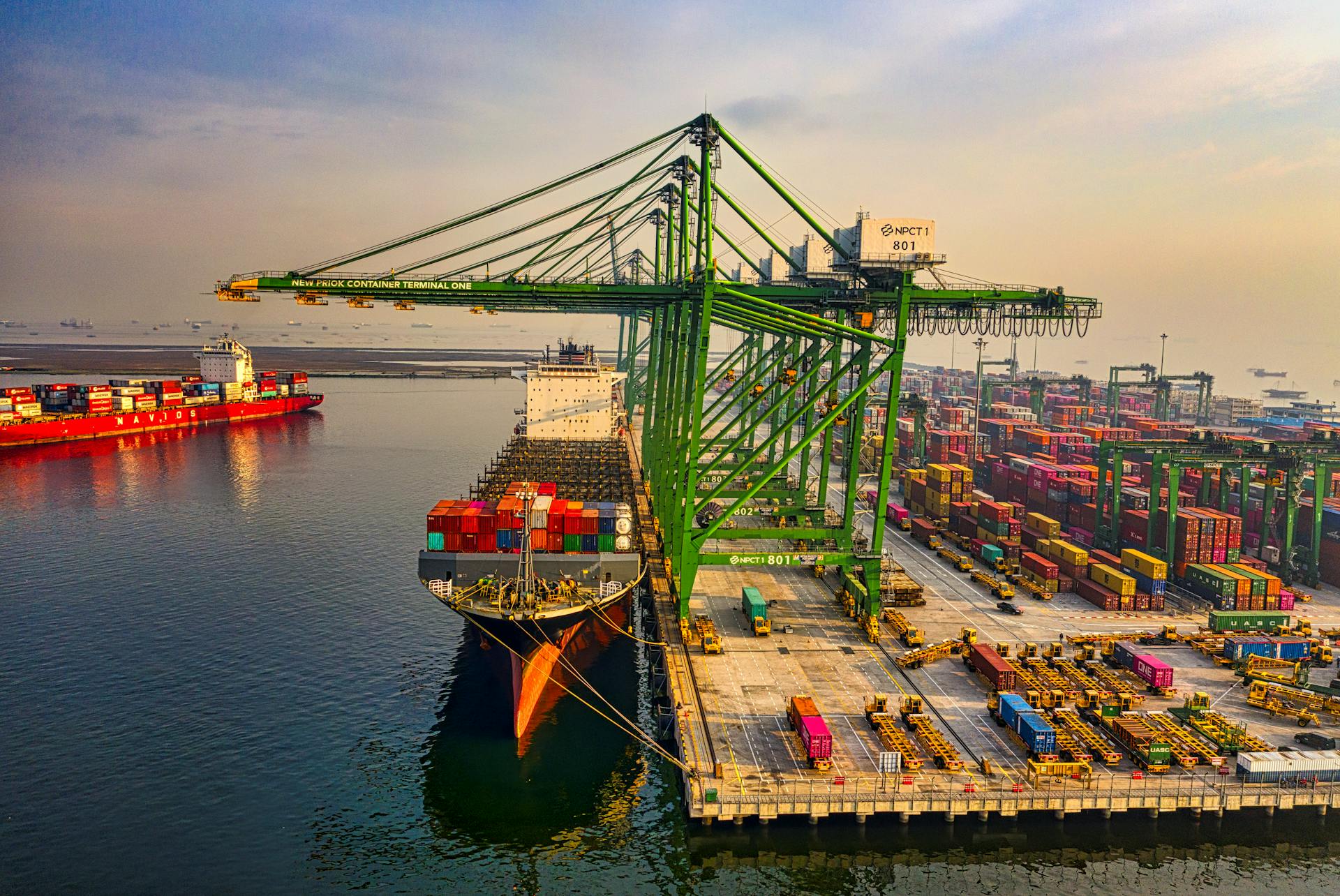
The Georgia Ports Authority is a shining example of how a public-private partnership can drive economic development and growth. With a strong focus on innovation and efficiency, the GPA has been able to increase cargo volumes and create jobs.
The GPA's strategic location on the Atlantic coast makes it an ideal hub for international trade. The ports' proximity to major markets in the southeastern United States and the Caribbean Basin gives them a unique competitive advantage.
The GPA has invested heavily in modernizing its infrastructure, including the deepening of the Savannah Harbor to 47 feet. This has allowed larger ships to call on the port, increasing cargo capacity and reducing transit times.
By leveraging its resources and expertise, the GPA has been able to attract new businesses and industries to the region, creating a thriving economic ecosystem.
Economic Impact and Projects
The Georgia Ports Authority has a significant economic impact on the state, supporting over 439,220 jobs in 2017. These jobs account for about 9 percent of total state employment.
Port activity in Georgia generated about $106 billion in statewide sales. This figure highlights the importance of the ports in driving economic growth.
The ports also brought in substantial tax revenue, with federal taxes totaling $5.9 billion, state taxes totaling $1.4 billion, and local taxes totaling $1.5 billion.
Economic Impact
Georgia's ports play a significant role in the state's economy, supporting 439,220 full- and part-time jobs throughout the state as of 2017.
Port activity accounted for about 9 percent of total state employment.
The ports also generated about $25 billion in personal income.
Port trade brought in about $106 billion in statewide sales.
This economic activity also generated tax revenue, with federal taxes totaling $5.9 billion, state taxes totaling $1.4 billion, and local taxes totaling $1.5 billion.
Savannah Harbor Expansion Project
The Savannah Harbor Expansion Project is an ongoing dredging program aimed at deepening the harbor from 42 feet to 47 feet. This will enable large Neo-Panamax ships to call on the Port of Savannah.
The project began in 2015 and was about halfway completed as of February 2018. It's expected to be finished by 2021, allowing loaded ships to transport approximately 3,600 additional cargo containers through the harbor on each passage.
The estimated cost of the project is around $973 million, with 75% provided by the federal government and the remaining 25% from the state of Georgia. This significant investment will undoubtedly have a lasting impact on the local economy.
The project's completion will enable the Port of Savannah to handle larger vessels, increasing its cargo capacity and boosting economic growth in the region.
Facilities and Transportation
The Georgia Ports Authority has invested heavily in its Brunswick facilities, which include three deepwater terminals: Mayor's Point Terminal, Colonel's Island Terminal, and East River Terminal. Mayor's Point Terminal was built starting in 1959 on land donated by the city of Brunswick and Glynn County.
Colonel's Island Terminal is particularly notable for its export and import shipments of automobiles. The GPA bought Colonel's Island near Brunswick in 1962.
The GPA also built East River Terminal on property acquired in the area of the old city dock in 1982. This bulk and general cargo facility is operated by a private company.
Brunswick Facilities
The Brunswick facilities are a crucial part of the Port of Brunswick, and they're quite impressive. The GPA owns and operates three deepwater terminals: Mayor's Point Terminal, Colonel's Island Terminal, and East River Terminal.
Mayor's Point Terminal is a general cargo site that was built by the GPA in 1959 on land donated by the city of Brunswick and Glynn County. It's a significant facility that has been in operation for over 60 years.
Colonel's Island Terminal is especially notable for its export and import shipments of automobiles. The facility has three berths and three on-terminal auto processors, making it an efficient hub for auto trade.
The Port of Brunswick also includes two other GPA-owned deepwater terminals: Mayor's Point Terminal and East River Terminal. Here are the details on these facilities:
East River Terminal and Lanier Dock, operated by Logistec U.S.A., specializes in the handling of break-bulk and bulk commodities. It features 1,600 feet of deepwater berthing, approximately 688,000 square feet of covered storage, and 15 acres of open, versatile storage.
River Transportation
The Georgia Ports Authority (GPA) has a strong focus on river transportation, with two key facilities along the Flint and Chattahoochee rivers.
The Bainbridge Inland Barge Terminal, owned and operated by the GPA, is located on the Flint River. It was constructed in 1957 on land deeded to the authority by the state.
This terminal handles both liquid and dry bulk commodities, such as petroleum products and petrochemicals.
The Columbus Inland Barge Terminal, also owned by the GPA, is located farther up the Chattahoochee River in Columbus. It was built on land deeded by the city of Columbus in 1961.
The terminal is operated by a private company and is used for handling liquid bulk commodities, including crude oil.
The GPA's mission is to develop, maintain, and operate ocean and inland river ports, which is reflected in its investment in these river transportation facilities.
Specific Ports and Information
The Port of Brunswick is a significant part of the GPA's operations, featuring three deepwater terminals: Colonel's Island Terminal, Mayor's Point Terminal, and East River Terminal.
The Colonel's Island Terminal is a 1,700-acre facility with three berths and three on-terminal auto processors, handling break-bulk and project cargo. It features 3,355 feet of continuous berthing and circa 637 acres of paved open storage.
Here's a brief overview of the three terminals:
- Colonel's Island Terminal: 3 berths, 3 on-terminal auto processors, 3,355 feet of continuous berthing, and 637 acres of paved open storage.
- Mayor's Point Terminal: 22 acres, 1,200 feet of deepwater berthing, 355,000 square feet of covered storage, and 7.9 acres of open storage.
- East River Terminal and Lanier Dock: 66 acres, 1,600 feet of deepwater berthing, 688,000 square feet of covered storage, and 15 acres of open storage.
The Port of Savannah is another major player, handling nearly 10 percent of total U.S. containerized cargo volume.
Savannah Port
The Savannah Port is a major hub for cargo distribution in the Southeast United States. It's one of the busiest ports in the country, handling nearly 10 percent of total U.S. containerized cargo volume.
The port has two major facilities: the Garden City Terminal and the Ocean Terminal. The Garden City Terminal is a secured, dedicated container terminal that's the largest single-operator container terminal in North America. It features 9,693 feet of continuous berthing and over 1.1 million square feet of covered storage.
The Ocean Terminal, on the other hand, is a breakbulk cargo facility specializing in the rapid and efficient handling of forest and solid wood products, steel, and other heavy-lift cargoes. It features 3,599 feet of deepwater berthing and over 1.4 million square feet of covered storage.
Here are some key statistics about the Savannah Port:
- Handles nearly 10 percent of total U.S. containerized cargo volume
- Features the largest single-terminal container facility in the U.S.
- Has the longest contiguous dock in the U.S. of nearly 10,000 linear feet
- Offers transit times as low as 23 days from Asia and 11 days from Europe
The port is also a major hub for refrigerated goods, with the largest Southeast refrigerated container import-export terminal. It has a unique intermodal infrastructure served by CSX Transportation and Norfolk Southern Railroad, making it an ideal location for cargo distribution.
Port of Brunswick
The Port of Brunswick is a significant player in the region's maritime trade. It's located in a strategic spot that allows for easy access to the Atlantic Ocean.
The Port of Brunswick includes three GPA-owned deepwater terminals, which are a testament to its importance in the shipping industry. These terminals are operated by both the GPA and private companies, highlighting the collaborative approach to port management.
Colonel's Island Terminal is one of the largest facilities, covering an impressive 1,700 acres and featuring 3,355 feet of continuous berthing. This is a game-changer for break-bulk and project cargo, which are handled at this terminal.
Mayor's Point Terminal specializes in break-bulk and project cargo, particularly forest products. This 22-acre facility has 1,200 feet of deepwater berthing and over 355,000 square feet of covered storage.
East River Terminal and Lanier Dock, operated by Logistec U.S.A., is another significant facility, covering 66 acres and featuring 1,600 feet of deepwater berthing. This terminal handles break-bulk and bulk commodities.
Here's a breakdown of the three GPA-owned deepwater terminals:
- Colonel's Island Terminal: 1,700 acres, 3,355 feet of continuous berthing
- Mayor's Point Terminal: 22 acres, 1,200 feet of deepwater berthing
- East River Terminal and Lanier Dock: 66 acres, 1,600 feet of deepwater berthing
Frequently Asked Questions
What are Georgia's three major ports?
Georgia's major ports include Savannah, Brunswick, and inland terminals in Murray County and Bainbridge, which serve as gateways to the world. These ports facilitate the flow of raw materials and finished products globally.
Sources
- https://en.wikipedia.org/wiki/Georgia_Ports_Authority
- https://www.georgiaencyclopedia.org/articles/business-economy/georgia-ports-authority/
- https://otdw.net/georgia-ports-third-party-logistics/
- https://www.tradeandindustrydev.com/region/georgia/georgia-ports-authority-10970
- https://www.savannahchamber.com/economic-development/the-ports/
Featured Images: pexels.com


